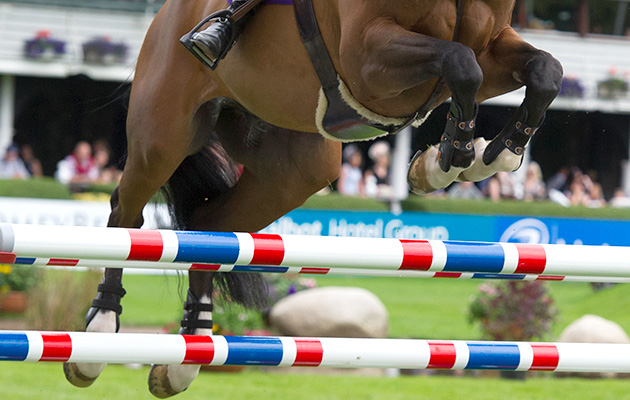Since H&H’s report in February on the ways sponsorship can help both parties, consultants and riders have expanded on how sponsorship should be approached so it works to provide the maximum benefit for all involved...
Riders hoping to work with sponsors must “play by the rules” and work in a manner that benefits all involved, experts agree.
H&H reported this year (news, 13 February) on the ways such deals can work for both sponsor and sponsored. Consultants and riders have since expanded on the ways sponsorship should be approached so it works as intended.
{"content":"PHA+U2FyYWggU2tpbGxpbiBvZiBFcXVpY29uc3VsdGluZywgd2hvIHdvcmtzIHdpdGggYm90aCBicmFuZHMgYW5kIHJpZGVycywgc2FpZCB0aGF0IHdpdGggaGVyIGZvcm1lciBoYXQgb24sIHNoZSBoYXMgc2VlbiByaWRlcnMgYXBwcm9hY2ggdG8gYXNrIGZvciBzcG9uc29yc2hpcCBiYXNlZCBvbiB0aGVpciBzb2NpYWwgbWVkaWEgZm9sbG93aW5nLjwvcD4KPHA+4oCcSSBnZXQgcGVvcGxlIHNheWluZywgZXNzZW50aWFsbHksIOKAmEnigJl2ZSBnb3QgMjUsMDAwIGZvbGxvd2VycyBhbmQgbG92ZSB5b3VyIHByb2R1Y3Q7IGNhbiBJIGhhdmUgYSBmcmVlIHNhZGRsZT\/igJkgYmVjYXVzZSB0aGV54oCZdmUgYmVlbiBjb25kaXRpb25lZCB0byB0aGluayB0aGUg4oCYaW5mbHVlbmNlcuKAmSBpcyBrZXksIGFuZCBpZiB5b3XigJl2ZSBnb3QgYSBiaWcgc29jaWFsIG1lZGlhIGZvbGxvd2luZywgZnJlZSBzdHVmZiBpcyBhIGdvZC1naXZlbiByaWdodC4gV2hhdCB0aGV5IGRvbuKAmXQgdGFrZSBpbnRvIGFjY291bnQgaXMgZXZlcnl0aGluZyBlbHNlIHRoYXQgaGFzIHRvIGdvIGludG8gaXQsIGFuZCB0aGUgd29yayBldGhpYy7igJ08L3A+CjxwPk1zIFNraWxsaW4gc2FpZCBhcyB3ZWxsIGFzIGxvd2VyLWxldmVsIGJ1dCBiZXR0ZXItZm9sbG93ZWQgcmlkZXJzLCB0aGVyZSBhcmUgcHJvcyB3aG8gZ2V0IGluIHRvdWNoIHRvIHNheSB0aGV5IGxpa2UgYSBicmFuZCBhbmQg4oCcd2hhdCBhcmUgeW91IGdvaW5nIHRvIGdpdmUgbWUsIGFzIEnigJltIGEgZml2ZS1zdGFyIHJpZGVyP+KAnTwvcD4KPHA+PGRpdiBjbGFzcz0iYWQtY29udGFpbmVyIGFkLWNvbnRhaW5lci0tbW9iaWxlIj48ZGl2IGlkPSJwb3N0LWlubGluZS0yIiBjbGFzcz0iaXBjLWFkdmVydCI+PC9kaXY+PC9kaXY+PHNlY3Rpb24gaWQ9ImVtYmVkX2NvZGUtMzEiIGNsYXNzPSJoaWRkZW4tbWQgaGlkZGVuLWxnIHMtY29udGFpbmVyIHN0aWNreS1hbmNob3IgaGlkZS13aWRnZXQtdGl0bGUgd2lkZ2V0X2VtYmVkX2NvZGUgcHJlbWl1bV9pbmxpbmVfMiI+PHNlY3Rpb24gY2xhc3M9InMtY29udGFpbmVyIGxpc3RpbmctLXNpbmdsZSBsaXN0aW5nLS1zaW5nbGUtc2hhcmV0aHJvdWdoIGltYWdlLWFzcGVjdC1sYW5kc2NhcGUgZGVmYXVsdCBzaGFyZXRocm91Z2gtYWQgc2hhcmV0aHJvdWdoLWFkLWhpZGRlbiI+DQogIDxkaXYgY2xhc3M9InMtY29udGFpbmVyX19pbm5lciI+DQogICAgPHVsPg0KICAgICAgPGxpIGlkPSJuYXRpdmUtY29udGVudC1tb2JpbGUiIGNsYXNzPSJsaXN0aW5nLWl0ZW0iPg0KICAgICAgPC9saT4NCiAgICA8L3VsPg0KICA8L2Rpdj4NCjwvc2VjdGlvbj48L3NlY3Rpb24+PC9wPgo8cD5NcyBTa2lsbGluIHNhaWQgcmlkZXJzIG5lZWQgdG8gY29uc2lkZXIgaG93IHRoZXkgd29yayB3aXRoIHRoZWlyIHNwb25zb3JzLCBob3cgdGhleSBwcmVzZW50IHRoZW1zZWx2ZXMgYW5kIHdoZXRoZXIgdGhleSBhcmUgZ29vZCBhbWJhc3NhZG9ycyBpbiBnZW5lcmFsLjwvcD4KPHA+4oCcSSB3YW50IHRvIHdvcmsgd2l0aCBwZW9wbGUgd2hvIGFscmVhZHkgdXNlIHRoZSBwcm9kdWN0LCBhbmQgc2F5IGhvdyBnb29kIGl0IGlzLCBhbmQg4oCYaG93IGNhbiBJIGhlbHA\/4oCZ4oCdIHNoZSBzYWlkLCBhZGRpbmcgdGhhdCByaWRlcnMgbXVzdCBiZWFyIGluIG1pbmQgd2hhdCB0aGV5IGNhbiBvZmZlciB0aGUgc3BvbnNvciwgd2hlbiBsb29raW5nIGZvciBkZWFscy48L3A+CjxwPldoZW4gc2hlIHdvcmtzIHdpdGggdGhlIHJpZGVycywgc2hlIGFkZGVkLCBzaGUgd2lsbCBoYXZlIG1hcmtldGluZyBwbGFucyBzZXR0aW5nIG91dCB3aGF0IHRoZXkgY2FuIGRvLCBzdWNoIGFzIHRhcmdldGVkIHNvY2lhbCBtZWRpYSBwb3N0cywgYW5kIGRlcGVuZGluZyBvbiB0aGUgYnJhbmQuIEEgc29jayBjb21wYW55IG1pZ2h0IGp1c3Qgd2FudCBwZW9wbGUgdG8ga25vdyBhIHRvcCBldmVudGVyIHdlYXJzIGl0cyBzb2Nrcywgd2hpbGUgYSBtYW51ZmFjdHVyZXIgbWlnaHQgd2FudCBkaXJlY3QgcmVmZXJyYWxzIHRvIHRoZWlyIGJ1c2luZXNzLjwvcD4KPGRpdiBjbGFzcz0iYWQtY29udGFpbmVyIGFkLWNvbnRhaW5lci0tbW9iaWxlIj48ZGl2IGlkPSJwb3N0LWlubGluZS0zIiBjbGFzcz0iaXBjLWFkdmVydCI+PC9kaXY+PC9kaXY+CjxwPk1zIFNraWxsaW4gYWxzbyBhZHZpc2VzIHJpZGVycyB0byB3b3JrIHdpdGggY29tcGFuaWVzIHdob3NlIHByb2R1Y3RzIHRoZXkgYWxyZWFkeSB1c2UgYW5kIHN1cHBvcnQsIGFzIHRoaXMgaXMg4oCcZG9pbmcgaXQgZm9yIHRoZSByaWdodCByZWFzb25z4oCdLCBhbmQgYmVpbmcgZ2VudWluZSBpbiB0aGVpciBzdXBwb3J0LCByYXRoZXIgdGhhbiBiZWluZyBnaXZlbiBhIG5ldyBwcm9kdWN0IHRvIHRyeSwgYXMgdGhpcyB3aWxsIGluZXZpdGFibHkgc3dheSB0aGVpciBvcGluaW9uLiBTaGUgYWxzbyB3YXJuZWQgdGhhdCBlbmRvcnNlbWVudCBvZiBjb21wYW5pZXMgd2l0aCB3aGljaCBhIHJpZGVyIGhhcyBhIGRlYWwsIGluY2x1ZGluZyBhbWF0ZXVycyB3aG8gYXJlIGFnZW50cyBmb3IgaW5zdXJlcnMgYW5kIGVhcm4gY29tbWlzc2lvbiwgZm9yIGV4YW1wbGUsIG5lZWQgdG8gYmUgY2xhcmlmaWVkIGFzIHN1Y2gsIG9yIGZhbGwgZm91bCBvZiB0aGUgQWR2ZXJ0aXNpbmcgU3RhbmRhcmRzIEFnZW5jeS48L3A+CjxwPuKAnEnigJl2ZSBoYWQgYnJhbmRzIHNheSB0aGV5IGdhdmUgYSByaWRlciDCozEsMDAwIG9mIHN0dWZmIGFuZCBnb3Qgbm90aGluZyBzbyB0aGV5IHdvbuKAmXQgc3BvbnNvciBhbnlvbmUgbm93LOKAnSBzaGUgc2FpZC4g4oCcVGhlIG1vcmUgeW91IGdlbmVyYXRlIGZvciBhIGJyYW5kLCB0aGUgbW9yZSB0aGV54oCZcmUgbGlrZWx5IHRvIGdpdmUgeW91IGJ1dCBhbHNvLCB0aGUgYmV0dGVyIGl0IGlzIGZvciB0aGUgaW5kdXN0cnk7IGlmIHRoZSB3aG9sZSBpbmR1c3RyeSBwbGF5cyBieSB0aGUgcnVsZXMsIGl04oCZcyBiZXR0ZXIgZm9yIGV2ZXJ5b25lLuKAnTwvcD4KPGRpdiBjbGFzcz0iYWQtY29udGFpbmVyIGFkLWNvbnRhaW5lci0tbW9iaWxlIj48ZGl2IGlkPSJwb3N0LWlubGluZS00IiBjbGFzcz0iaXBjLWFkdmVydCI+PC9kaXY+PC9kaXY+CjxwPkNsYWlyZSBLaW5nLCB3aG8gYWxzbyB3b3JrcyB3aXRoIHJpZGVycyBpbiBhIHNpbWlsYXIgbWFubmVyLCBhZ3JlZXMgdGhhdCBwZW9wbGUgc2hvdWxkIHdvcmsgd2l0aCBicmFuZHMgdGhleSBrbm93IGFuZCBsaWtlIGFscmVhZHksIHNvIHRoZXkgY2FuIHByb3ZpZGUgYSB0YWlsb3JlZCBhcHByb2FjaC48L3A+CjxwPuKAnEFuZCBwaXRjaCB0byB5b3VyIGF1ZGllbmNlLOKAnSBzaGUgdG9sZCA8ZW0+SCZhbXA7SDwvZW0+LiDigJxJZiB5b3XigJlyZSBhbiBldmVudGVyIGFuZCBhIGNvbXBhbnkgZG9lc27igJl0IGhhdmUgYSBwcmVzZW5jZSBpbiBldmVudGluZywgZG9u4oCZdCBnbyB0byB0aGVtLiBCZSB2ZXJ5IGZvY3VzZWQsIGFuZCBsb29rIGF0IHdobyBhIGJyYW5kIGhhcyBhbHJlYWR5IGFuZCB3aGF0IHlvdSBjYW4gYWRkIHRvIHRoZSBtaXg7IGlmIHRoZWlyIGFtYmFzc2Fkb3JzIGFyZSBhbGwgbWFsZSBhbmQgeW914oCZcmUgZmVtYWxlLCB5b3UgbWlnaHQgaGF2ZSBtb3JlIG9mIGEgY2hhbmNlLuKAnTwvcD4KPGRpdiBjbGFzcz0iYWQtY29udGFpbmVyIGFkLWNvbnRhaW5lci0tbW9iaWxlIj48ZGl2IGlkPSJwb3N0LWlubGluZS01IiBjbGFzcz0iaXBjLWFkdmVydCI+PC9kaXY+PC9kaXY+CjxwPk1zIEtpbmcgYWR2aXNlcyByZXNlYXJjaGluZyBicmFuZHMgYW5kIGNvbXBhcmluZyB0aGVpciBpZGVudGl0aWVzIHdpdGggeW91ciBvd24sIHRvIHNlZSBpZiB0aGVyZSBpcyBhIGZpdC4gQW5kIHdoaWxlIDUwLDAwMCBJbnN0YWdyYW0gZm9sbG93ZXJzIGRvZXMgbm90IGd1YXJhbnRlZSBmcmVlIHByb2R1Y3RzLCBsb3dlci1sZXZlbCBncmFzc3Jvb3RzIHJpZGVycyB3aG8gaGF2ZSBlbmdhZ2luZywgaW50ZXJhY3RpdmUgc29jaWFsIG1lZGlhIGZvbGxvd2luZ3MgYXJlIGFsc28gdmFsdWFibGUgdG8gYnJhbmRzLjwvcD4KPHA+RXZlbnRlciBJbW9nZW4gTXVycmF5IHRvbGQgPGVtPkgmYW1wO0g8L2VtPiB3b3JraW5nIHdpdGggTXMgU2tpbGxpbiBoYXMgY2hhbmdlZCB0aGUgd2F5IHNoZSB3b3JrcyB3aXRoIHNwb25zb3JzLiBOb3csIGlmIGEgYnJhbmQgbWFrZXMgYW4gYXBwcm9hY2gsIHRoZSB0ZWFtIHdpbGwgZGlzY3VzcyB3aXRoIGl0IHRoZSB3YXlzIHRoZXkgY2FuIHdvcmsgdG9nZXRoZXIgYW5kIHdoYXQgZXhwZWN0YXRpb25zIGFyZSwgc3VjaCBhcyB3aGVuIEltb2dlbiB3aWxsIGJlIGF2YWlsYWJsZSB0byBtZWV0IHBlb3BsZSBhdCBhIGJpZyBldmVudC48L3A+CjxwPuKAnFRoZXJl4oCZcyBhIGdyZWF0IGdpcmwgd2hvIHNlbmRzIG1lIGNsb3RoZXMgYW5kIGp1c3Qgd2FudHMgbWUgdG8gd2VhciB0aGVtLCB3aGljaCBJIGRpZCBhbnl3YXk7IHNoZSBtYWtlcyBteSBjcm9zcy1jb3VudHJ5IHRvcHMgYW5kIGlmIEnigJltIGludGVydmlld2VkIGluIHRoZW0sIHNoZeKAmXMgb3ZlciB0aGUgbW9vbizigJ0gSW1vZ2VuIHNhaWQuIOKAnE90aGVyIGJyYW5kcyBuZWVkIHlvdSB0byBkbyBtb3JlIGFuZCB0aGF04oCZcyBmaW5lLCBpdOKAmXMgYWxsIGFib3V0IGJlaW5nIG9wZW4gYW5kIGhvbmVzdCBzbyBpdCB3b3JrcyBvbiBib3RoIHNpZGVzLjwvcD4KPHA+4oCcSSB3b3VsZG7igJl0IHRha2Ugc3BvbnNvcnNoaXAgaWYgSSBkaWRu4oCZdCBvciBoYWRu4oCZdCB1c2VkIHRoZSBwcm9kdWN0IGFzIGl04oCZcyBkaWZmaWN1bHQgdG8gcHJvbW90ZSBzb21ldGhpbmcgeW91IGRvbuKAmXQgYmVsaWV2ZSBpbiDigJMgYW5kIEkgd291bGRu4oCZdCBkbyBhbnl0aGluZyB0aGF0IHdvdWxkIGNvbXByb21pc2UgdGhlIGhvcnNlc+KAmSBjYXJlLCBhbmQgZXZlcnkgaG9yc2UgaXMgZGlmZmVyZW50LuKAnTwvcD4KPHA+RmlvbmEgTmVsbGlzLCBnZW5lcmFsIG1hbmFnZXIgb2YgSG9yc2VseXgsIHRvbGQgPGVtPkgmYW1wO0g8L2VtPiB0aGUgY29tcGFueSBoYXMgcmVnaW9uYWwgYW1iYXNzYWRvcnMgYW1vbmcgaXRzIHRlYW0gb2YgYXNzb2NpYXRlZCByaWRlcnMsIGJ1dCBpdCBhbHNvIGhhcyBhIHBoeXNpb3RoZXJhcGlzdCBhbmQgYSBmYXJyaWVyIG9uIGJvYXJkLjwvcD4KPHA+4oCcT3VyIHRob3VnaHRzIGhlcmUgd2VyZSBsb29raW5nIGF0IGRpZmZlcmVudCBhc3BlY3RzIG9mIHRoZSBoZWFsdGggYW5kIHdlbGxiZWluZyBvZiB0aGUgaG9yc2UgYW5kIGhvdyBIb3JzbHl4IGNhbiBiZSBvZiBiZW5lZml0IGR1cmluZyB3aGF0IGNvdWxkIGJlIHN0cmVzc2Z1bCB0aW1lcyBmb3IgdGhlIGhvcnNlLOKAnSBzaGUgc2FpZC48L3A+CjxkaXYgY2xhc3M9ImluamVjdGlvbiI+PC9kaXY+CjxwPuKAnFRoZSBiZW5lZml0cyBJIHdvdWxkIGxpa2UgdG8gdGhpbmsgYXJlIGFzIG11Y2ggZm9yIHRoZSBzdXBwb3J0ZWQgaW5kaXZpZHVhbCBhcyBmb3IgdXMg4oCTIGl0IGdpdmVzIHRoZSByaWRlciB0byBvcHBvcnR1bml0eSB0byBmZWVkIG91ciBiYWxhbmNlciwgd2Ugb2ZmZXIgdHJhaW5pbmcgdG8gdGhlIGFtYmFzc2Fkb3IgYWJvdXQgdGhlIGZlYXR1cmVzIGFuZCBiZW5lZml0cyBvZiBmZWVkaW5nIEhvcnNseXggd2hpY2ggY2FuIGJlIGJlc3Bva2UgdG8gZWFjaCBpbmRpdmlkdWFsIGhvcnNlLCBhbmQgdGhleSBzZWUgdGhlIHJlc3VsdHMuIEZvciB1cywgdGhleSBicmluZyBmdXJ0aGVyIGNyZWRpYmlsaXR5IHRoYXQgcmlkZXJzIGNvbXBldGluZyBpbiB0aGUgcHVibGljIGZvcnVtIHdhbnQgdG8gdXNlIG91ciBwcm9kdWN0cy7igJ08L3A+CjxwPgo="}
You may also be interested in…
Stay in touch with all the news in the run-up to and throughout the major shows and events during 2025 and beyond with a Horse & Hound subscription. Subscribe today for all you need to know ahead of these major events, plus online reports on the action as it happens from our expert team of reporters and in-depth analysis in our special commemorative magazines. Have a subscription already? Set up your unlimited website access now
H&H news editor
Eleanor is an experienced journalist who spent over eight years working for local and national newspapers before joining H&H as news editor in March 2016. Passionate about equine welfare and exposing the truth, Eleanor has reported on all aspects of the industry, from Brexit to anti-bullying campaigns, and from dressage rules to mules. Her sport of choice is showjumping, in which she competes her own horses, and she also enjoys reporting at local jumping shows through to international championships.






